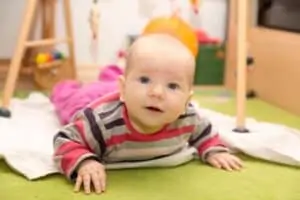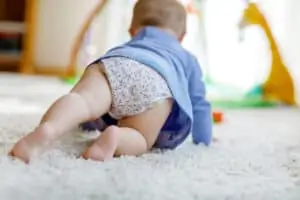Now that you’re moving past the newborn phase and the baby is showing her unique personality, you’re about to get into more movement. You may wonder about baby crawling styles as you complete the babyproofing tasks around your house.
Is there one that is better than the other? Are they normal? What in the world do they mean?!?
Calm down, Mama dear, for any sign of locomotion on your child’s part is a step in the right direction, pardon the pun.
Let’s look at all those baby crawling styles so you know what your baby is doing when she’s doing it.
What are the different types of crawling?
There are 8 different types of crawling styles your baby may display. You don’t need to worry when they try these out as long as they attempt them in safe spaces. The best places to let your baby crawl are on softer surfaces, like carpet, area rugs, or on top of padding.
Doing so on these surfaces is less slippery, so they have a better grip. It’s also gentler on the knees and hands.
And please, again, I must insist that you make sure your home is babyproofed or that the areas you keep your child in are secured. Gates at the stairs, covers on the outlets, and all those things to keep your precious sweetheart safe!
- Classic crawl
Crawling on hands and knees is considered the classic crawl. And while it’s surely a classic, it’s not the most common way babies will crawl. It’s when they move an arm and the opposite leg together to move forward. They develop more balance from this move, but if your baby isn’t crawling this way, there is nothing wrong with them, so please don’t worry.

- Belly crawl
I highlighted in another post that the belly crawl is also known as commando crawls or army crawl. This is what most babies tend to do when they start to crawl. They’ll drag themselves on their bellies across the floor for the combat crawl by using their arms. The legs hang back, not really doing anything to assist. For stomach crawling like this, get ready because this is one tough baby!
- Rolling crawl
It’s not precisely a crawl, but the rolling crawl does help the baby get around. And it’s pretty funny to see. My friend Katie’s daughter Amber did this, and we couldn’t stop laughing. If your baby is doing the rolling crawl, you’ll know. This happens after the 6-month mark when babies can roll. Be careful, though, as they can roll off a bed or other surface when they can do this. My eldest also loved to roll around; bless her sweet heart!
- Bear Crawl
Have you ever seen a baby bear in the wild? What a sight! But your baby likely hasn’t seen a baby bear crawling, which is what makes the bear crawl even more adorable. It’s a bit similar to the classic crawl, but your baby will keep their knees and elbows straight as they move around. It’s aptly named since they look like a baby bear crawling!
- Bottom scooting
Is your baby bottom scooting? Then you might just have a monkey crawl baby on your hands. You’ll know they’re doing this when they sit on their bottom and use their arms to move around, just like a monkey. And boy can they move like this, so watch out!
- Crab crawl
You’ll have to stifle your laughter when the baby does the crab crawl. It’s truly adorable! This usually happens when they’re first trying to crawl. She’ll move backward and sideways by propelling herself with her tiny hands. One leg will be bent underneath them while the other sticks to the side.
Why do I say try not to laugh?
Because the baby will be frustrated trying to crawl when she can’t move forward. Don’t discourage her; instead, get down on her level and show her how to crawl. She’ll hopefully soon copy your movements!
- Inchworm crawl
The baby inchworm crawl is a variation on the belly crawl or army crawl. She’ll pull herself forward with both arms at the same time. The difference is that she’ll raise herself a little with the baby inchworm crawl and then land down like she’s doing a belly flop. She’ll look like she’s about to bear crawl but then pulls off this move. Again, it can’t hurt to get down and show her how to work it out.
- Leapfrog crawl
And finally, there is a leapfrog crawl that babies may do too. This is when your baby is on her hands and knees and pushes themselves forward in this pose. It looks like when preschoolers play that leapfrog game, hence the name.
Is belly crawling considered crawling?
Technically, it’s creeping. And creeping comes after crawling. I explained the differences in my post about the army crawl, a creeping form.
You can call it what you like, though, because when you see belly crawling, classic crawling, or any of these other 8 types of crawls, it means your baby is making progress toward moving themselves around. And that’s certainly a cause for celebration!
Leslie Berry lives with her husband and two young daughters in Los Altos, California, where she loves helping other moms get comfortable with motherhood and embracing the insanity with facts peppered with laughs.
She loves eating too much sushi, exercising, and jamming out on her Fender. Read more about Leslie here.






